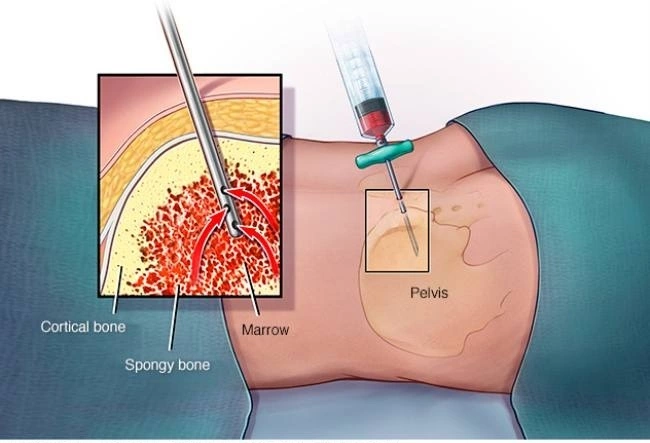Bone Marrow Transplant
Hematopoietic stem cell transplantation is a treatment option for several kinds of hematologic diseases. With the advances in transplantation technology, doctors have successfully treated blood cancers and disorders with Bone Marrow Transplant.
The early transplant-related mortality has reduced, and older patients are now also able to get this treatment. The survival rates are higher, and a wider variety of diseases can be cured with stem cell transplantation.
However, there can be some effects of this treatment that appear later, and the management of these late effects after stem cell transplantation is critical. Several conclusive studies have shown that the survivors might suffer from some significant impacts that can affect the morbidity, mortality, and quality of life.

Late effects are seen on many organs of the body, including – Cardiovascular disease, pulmonary, and endocrine systems. It may also cause dysfunctions of the thyroid gland, gonads, liver and kidneys, infertility, iron overload, bone diseases, infection, secondary cancer, and Neuropsychology effects.
The leading cause of late mortality is the recurrence of malignancy, lung diseases, infection, secondary cancers, and bone marrow rejection.
What are the effects of bone marrow transplant on the body?
Patients who are disease-free two years after a transplant have an 80% 10-year survival rate. Studies have shown that bone marrow transplant (BMT) recipients might suffer from significant late effects that end up adversely affecting the body organs.
The effects on individual body parts can be segregated into –
1) Cardiovascular System
- Cardiovascular diseases (CVD) after BMT can include – cardiomyopathy, congestive heart
failure, valvular dysfunction, arrhythmia, pericarditis, and coronary artery disease. - Their incidence is somewhat less, ranging in around 5%–10% in cases after 10 years post-transplant.
- The steps taken to improve are – lifestyle modification (weight reduction, dietary sodium
reduction, and regular physical activity) - These patients are also advised to follow antihypertensive drugs including angiotensin-
converting enzyme inhibitors and angiotensin II receptor blockers.
2) Pulmonary diseases
- Non-infectious complications of the lung include bronchiolitis obliterans syndrome (BOS),
cryptogenic organizing pneumonia (COP), and pulmonary hypertension. - Symptoms of BOS include – dyspnea, cough, and wheezing, but in the early BOS, the patient
might be asymptomatic. The symptoms first appear when there is some significant lung
functioning loss. - Pulmonary hypertension is rare but is a fatal complication, which has its incidence of around
3% in the total cases.
3) Endocrine diseases
- The majority of the complications include – thyroid dysfunction, diabetes, dyslipidemia, and adrenal insufficiency.
- Hypothyroidism occurs in around 30% of patients after a 25-year post-transplant follow up.
- Risk factors are – patients under the age of 10, conditioning containing radiation, busulfan or
cyclophosphamide, and hematologic malignancies. - Diabetes occurs in 8%–41% of patients after a successful transplant.
- Dyslipidemia occurs in 9%–61% of the patients.
- Adrenal insufficiency occurs in 13% of patients.
4) Male gonadal dysfunction and infertility
- Hypogonadism is common after HCT. The complications include – Impaired spermatogenesis,
erectile dysfunction, low testosterone, and low libido occur in male patients. - Erectile dysfunction and low libido result from both a psychological and physiological
reasons. - Azoospermia occurs in more than 70% of male patients.
5) Female gonadal dysfunction, infertility, and pregnancy
- Ovarian insufficiency, vaginal changes, and low libido occur in female patients.
- Ovarian failure is seen in more than 90% of female patients.
- The use of hormone replacement therapy for premature ovarian failure is individually decided based on the age, severity of menopausal symptoms, bone density, and the risk of breast cancer.
6) Iron overload
- Iron overload is rare but is seen more commonly in patients after an allogeneic transplant.
- Normal transferrin saturation is less than 50% in males and less than 45% in females. In
patients with iron overload, the saturation increases to more than 60%.
7) Liver diseases
- Late liver complications include chronic hepatitis B, chronic hepatitis C, liver cirrhosis, nodular
regenerative hyperplasia, and focal nodular hyperplasia. - Hepatitis B-infected patients are at a little higher risk than the rest.
- Hepatitis C virus infection is the most common and results in chronic hepatitis.
8) Kidney diseases
- Chronic kidney disease (CKD) is defined as an elevated serum creatinine level, or a decreased
glomerular filtration rate (GFR). - More than 20% of the post-transplant cases have some kidney suppression resulting in
complications.
9) Bone diseases
- Late complications include osteopenia, osteoporosis, and avascular necrosis (AVN).
- It has been reported in 50% of bone marrow transplant recipients.
10) Other infectious diseases
- Common late infections are caused by – Pneumocystis jirovecii, encapsulated bacteria, fungi, varicella-zoster virus (VZV), cytomegalovirus, and respiratory viruses.
- Patients also report more complications in the upper respiratory tract and sinus infections.
- The bone marrow transplant cost in India is relatively lower than in several other countries. However, it
may vary on certain factors such as
1) Type of blood cancer or disease that is being treated
2) Age of the patient
3) Type of the transplant – autologous or allogenic
4) Type of the donor – full match or a half-matched donor







